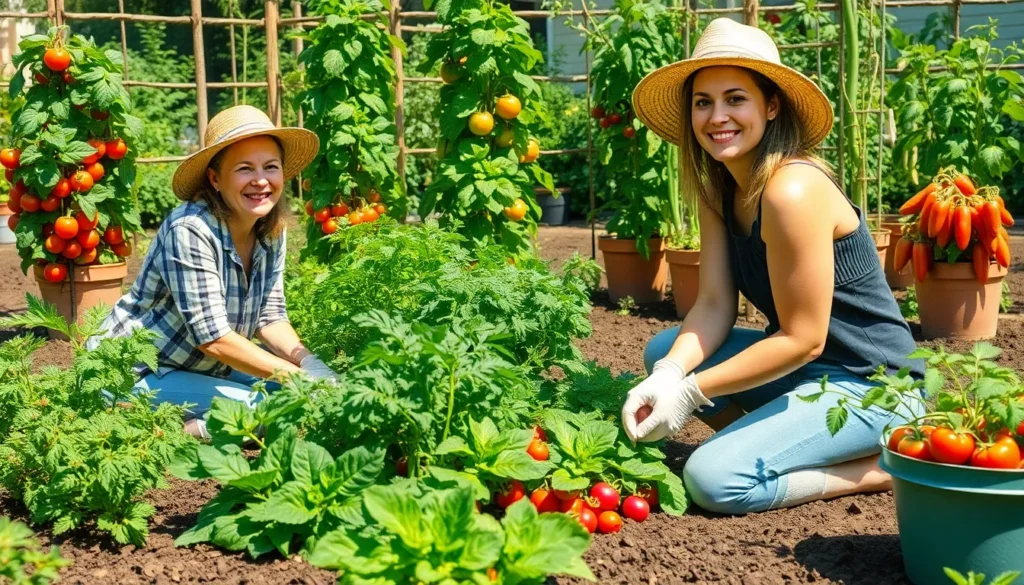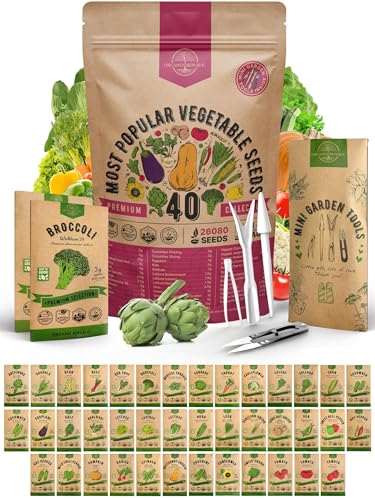Growing your own vegetables transforms both your dinner table and your connection to food. We’ve discovered that starting a vegetable garden doesn’t require acres of land or years of experience – just the right plant choices and a willingness to get your hands dirty.
Whether you’re working with a sprawling backyard or a compact balcony space we’ll show you how to maximize your harvest with smart vegetable selections. From quick-growing greens that’ll be ready in weeks to reliable staples that’ll feed your family all season long there’s something here for every gardener’s skill level and space constraints.
We’ve compiled the most rewarding vegetable varieties that consistently deliver impressive yields while being forgiving to newcomers. These aren’t just plants – they’re your gateway to fresher meals lower grocery bills and the satisfaction of growing your own food.
Start With Easy-to-Grow Beginner Vegetables
Choosing the right vegetables for your first garden sets you up for success and builds confidence in your growing abilities. We’ve selected varieties that forgive common mistakes while delivering impressive harvests in minimal time.
Lettuce and Leafy Greens
Lettuce varieties thrive in cooler weather and mature within 45-60 days from seed. We recommend starting with loose leaf types like Black Seeded Simpson or Red Sails since they don’t require perfect head formation. These greens tolerate partial shade and grow continuously when you harvest outer leaves first.
Spinach produces tender leaves in just 30-40 days and actually prefers cool spring or fall temperatures. Plant seeds directly in the ground every 2 weeks for continuous harvests throughout the growing season. Baby spinach leaves taste sweeter and more delicate than mature plants.
Arugula delivers peppery flavor in only 25-30 days from planting. This Mediterranean green self seeds readily and provides multiple cuttings from a single planting. Young arugula leaves add sophisticated taste to salads while older leaves work perfectly in cooked dishes.
Radishes and Quick Growing Roots
Cherry Belle radishes mature in an incredible 22-30 days, making them perfect for impatient gardeners. We plant these round red roots every week during spring and fall to maintain fresh supplies. Their compact size means you can fit dozens in small garden spaces.
French Breakfast radishes elongate rather than round and develop mild flavor in 25-35 days. These attractive pink and white roots grow well in containers and don’t become woody as quickly as other varieties. Harvest them when they reach finger length for the best texture.
Daikon radishes take longer at 60-70 days but produce massive white roots that store well through winter. We plant these Asian varieties in late summer for fall harvest when cooler weather improves their flavor. Each root can weigh 2-3 pounds when fully mature.
Bush Beans and Snap Peas
Bush beans eliminate the need for trellising while producing abundant harvests in 50-60 days. We prefer varieties like Provider or Blue Lake Bush since they set pods all at once for easier harvesting. These nitrogen fixing plants actually improve your soil for future plantings.
Sugar snap peas climb naturally and produce edible pods in 60-70 days from spring planting. Install simple bamboo teepees or wire fencing for support as these vines reach 4-6 feet tall. Fresh snap peas taste incredibly sweet when harvested young and tender.
Snow peas develop flat edible pods perfect for stir fries in just 55-65 days. We harvest these Asian varieties when pods feel plump but before individual peas bulge noticeably. Cool spring weather produces the most tender and flavorful snow pea pods.
Choose Space-Saving Vertical Garden Vegetable Ideas
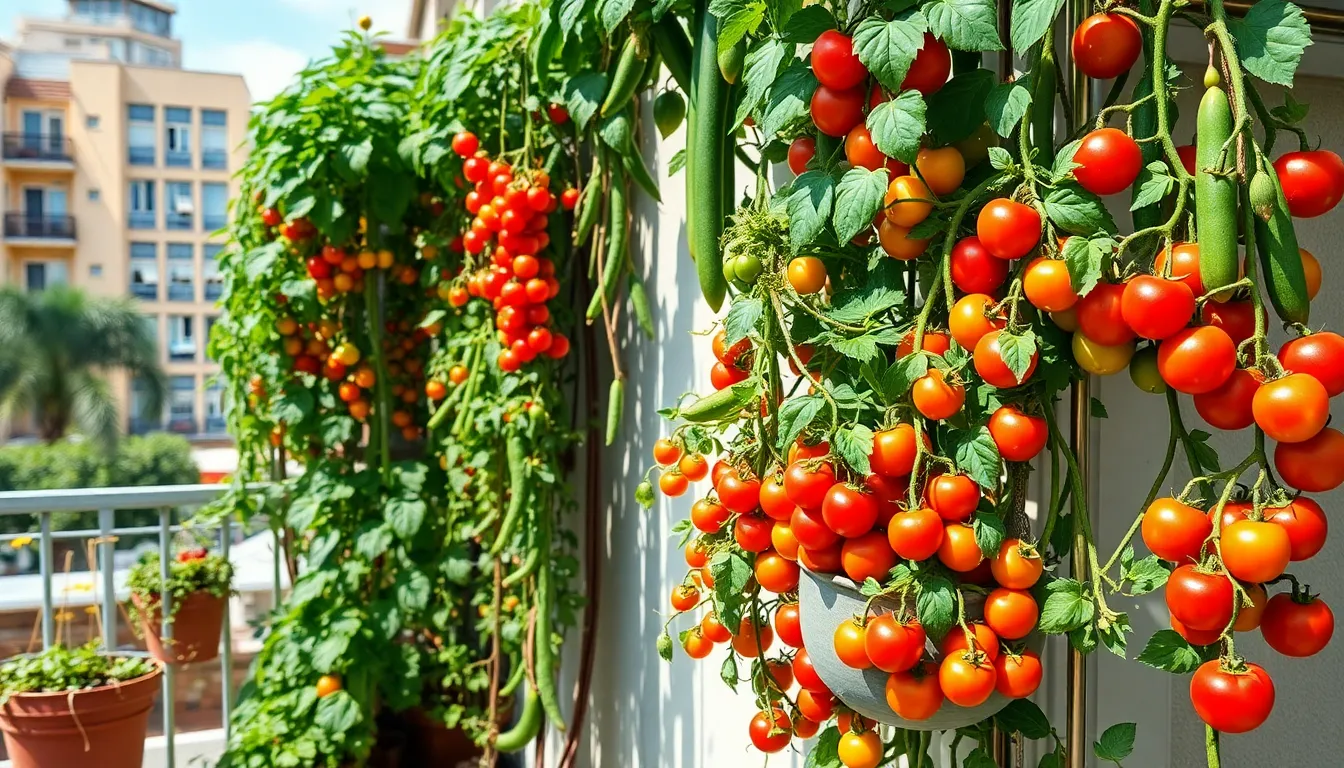
Maximizing your garden’s potential doesn’t require expanding outward when you can grow upward instead. We’ll explore proven vertical growing techniques that transform small spaces into productive vegetable gardens.
Climbing Tomatoes and Pole Beans
Indeterminate tomato varieties excel in vertical gardens by producing fruit continuously throughout the growing season. These climbing plants thrive when supported by sturdy trellises or wire cages that allow them to reach their full height potential. We recommend varieties like Cherokee Purple or Brandywine that naturally grow tall and benefit from vertical support systems.
Pole beans represent another perfect vertical gardening choice that climbs naturally without requiring extensive training. These productive plants can reach heights of 6-8 feet when properly supported by trellises or bamboo poles. Popular varieties like Kentucky Wonder and Scarlet Runner beans maximize space usage while delivering abundant harvests from minimal ground area.
Cucumber Trellises and Vine Supports
Cucumber plants love climbing and produce straighter, cleaner fruit when grown vertically on sturdy support structures. Trellising cucumbers keeps the developing fruit off the ground and ensures better air circulation around the plants. We’ve found that wire mesh panels or wooden trellis systems work exceptionally well for supporting these vigorous climbers.
Vine supports extend beyond cucumbers to accommodate other climbing vegetables like small squash varieties and compact melons. Wire mesh trellises provide excellent support for these heavier fruits while maximizing your growing space. Installing these support systems early in the season allows plants to establish strong climbing habits from the start.
Hanging Baskets for Cherry Tomatoes
Cherry tomato varieties thrive in hanging baskets that provide excellent drainage while creating stunning vertical displays. These compact plants produce abundant small fruits that cascade beautifully over basket edges. We recommend determinate cherry varieties like Tiny Tim or Tumbling Tom that stay compact and don’t require extensive pruning.
Hanging basket gardens work particularly well on balconies, patios, or indoor spaces where ground gardening isn’t possible. The elevated position improves air circulation around plants while making harvesting easier and more convenient. Strategic placement ensures your hanging gardens receive adequate sunlight while creating attractive vertical growing displays.
Plan High-Yield Compact Vegetable Varieties
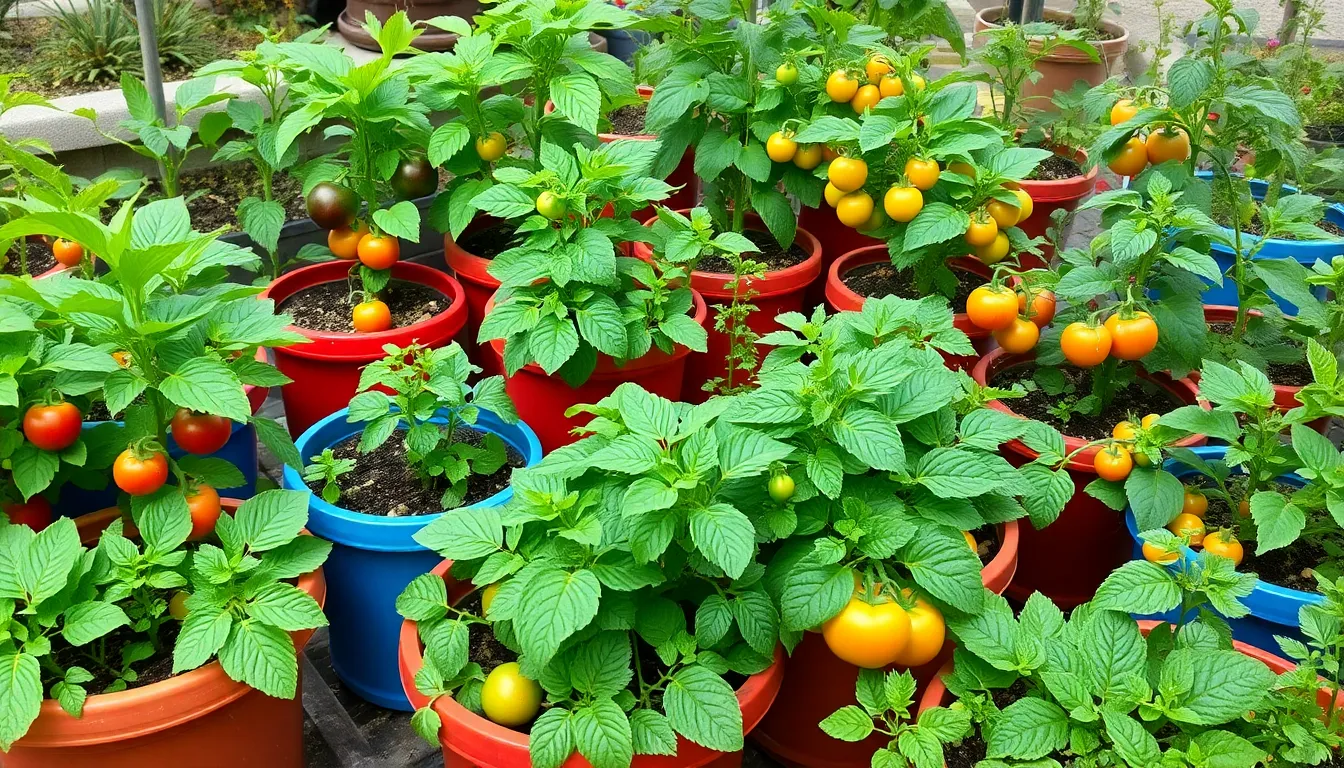
Smart variety selection transforms small gardens into productive powerhouses. We’ll focus on proven compact cultivars that deliver impressive harvests without overwhelming your space.
Dwarf Pepper Plants
Compact pepper varieties pack serious productivity into containers and tight garden spots. These petite plants typically reach 12-18 inches tall while producing abundant crops throughout the growing season.
Container gardening becomes effortless with dwarf pepper cultivars that thrive in 5-gallon pots. Space requirements shrink dramatically compared to full-size varieties, making them perfect for patios, balconies, and small raised beds.
Harvesting continues for months as these plants produce peppers consistently from midsummer through first frost. We recommend choosing varieties suited to your heat preference, from sweet bells to spicy jalapeños, all available in compact forms.
Bush Squash and Zucchini
Bush varieties revolutionize squash growing by eliminating sprawling vines that consume garden real estate. These compact plants produce impressive yields within a 3-4 foot diameter circle.
‘Black Beauty’ zucchini delivers exceptional productivity while maintaining a manageable size perfect for small gardens. ‘Grey’ zucchini offers similar compact growth with slightly different fruit characteristics for variety in your harvest.
Summer squash options expand with ‘Lioness’ and ‘Early Prolific’ varieties that produce abundantly throughout the growing season. These bush types require significantly less space than traditional vining squash while delivering comparable harvests.
Maintenance becomes simpler as bush varieties allow easier access for harvesting and pest management compared to sprawling vine types.
Determinate Tomato Options
Determinate tomatoes excel in small spaces by reaching predetermined heights and producing concentrated harvests. These compact plants typically grow 3-4 feet tall and require minimal staking compared to indeterminate varieties.
‘Red Robin’ creates perfect patio displays while producing cherry tomatoes continuously throughout the season. ‘Tiny Tim’ offers similar compact growth with slightly larger fruit production, ideal for container growing.
Harvesting patterns differ from indeterminate varieties as these plants produce most of their fruit within a 2-3 week window. This concentrated production works perfectly for preserving projects or when you need large quantities at once.
Support requirements remain minimal as these plants rarely exceed 4 feet in height, making them suitable for simple cages or stakes rather than elaborate trellis systems.
Select Season-Extending Cold-Hardy Vegetables
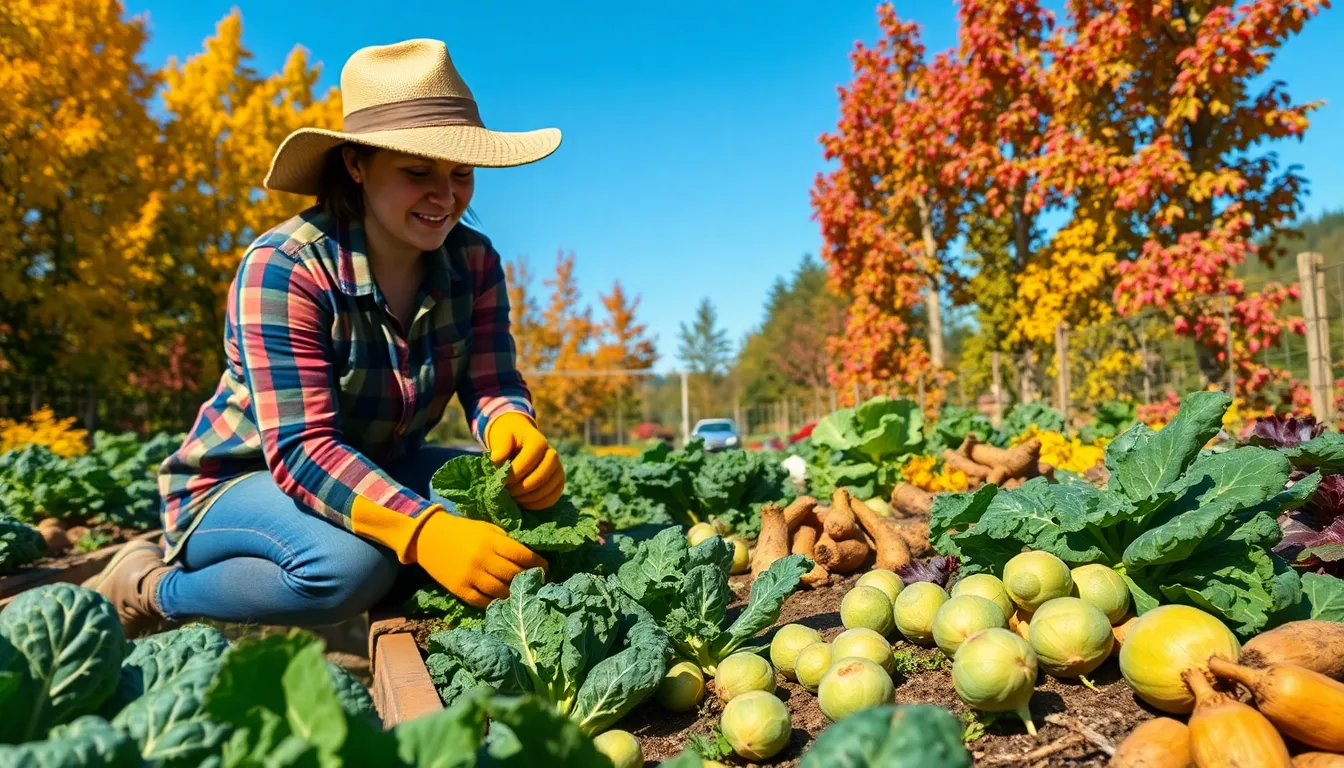
We’ll extend our growing season by choosing vegetables that thrive in cooler temperatures and tolerate frost. These hardy varieties provide fresh harvests well into fall and winter months.
Winter Spinach and Kale
Winter spinach transforms cold weather gardening with its exceptional frost tolerance and continuous growth through light freezes. Plant this cold-hardy crop in late summer for fall and early winter harvests that deliver fresh greens when other vegetables have finished producing. Spinach leaves actually develop sweeter flavors after exposure to cooler temperatures.
Kale reaches peak performance when planted about two months before your first expected frost date. This nutrient-dense green enhances its flavor profile as winter approaches, developing a sweeter taste that makes it more appealing in raw preparations. We recommend harvesting outer leaves while allowing the center to continue producing throughout the cold season.
Brussels Sprouts and Cabbage
Brussels sprouts require strategic timing with planting about four months before your first frost to reach proper maturity. These compact vegetables withstand temperatures as low as 20°F, making them reliable producers for winter harvests. Small sprouts develop better flavor after experiencing cold weather, which converts starches to sugars.
Cabbage demonstrates remarkable cold hardiness similar to Brussels sprouts, surviving harsh winter conditions while maintaining quality. Dense heads store well in cool conditions and provide versatile ingredients for winter cooking. We suggest choosing varieties specifically bred for fall harvests to maximize cold tolerance.
Root Vegetables for Fall Harvest
Beets rank among the most winter-hardy root crops in our gardens, tolerating frost while continuing to develop underground. Harvest these versatile vegetables when they reach 4-6 inches in diameter for optimal texture and flavor. Both roots and greens provide nutritional value throughout the extended growing season.
Carrots excel as cold-hardy options that can remain in the ground over winter in many regions, allowing for fresh harvests as needed. Cold temperatures actually improve carrot sweetness by converting starches to sugars. Mulching helps protect roots from freeze-thaw cycles while maintaining soil workability.
Parsnips develop their signature sweet flavor only after experiencing frost, making them ideal candidates for fall planting and winter harvesting. These hardy roots can withstand freezing temperatures while remaining in the ground, providing fresh vegetables throughout winter months when properly mulched.
Incorporate Heat-Loving Summer Garden Vegetables
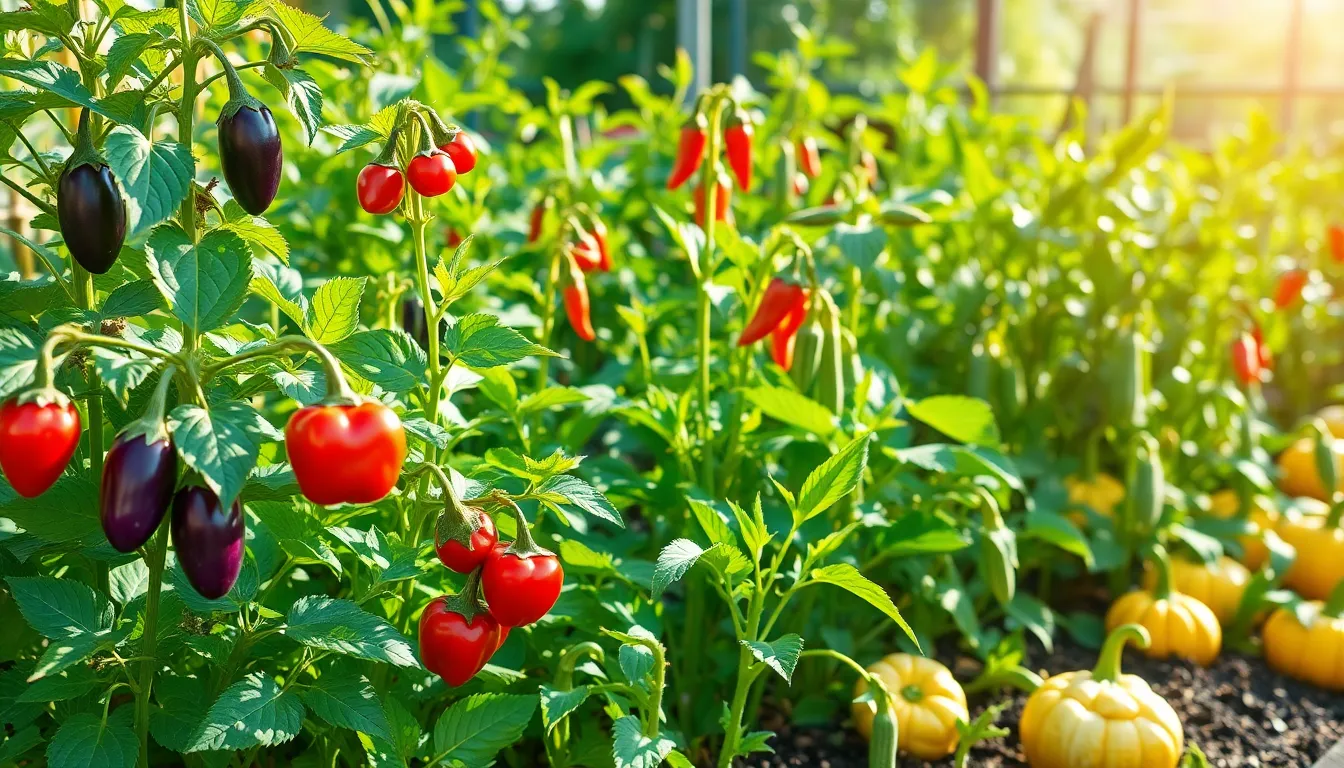
Summer’s intense heat doesn’t have to limit our vegetable garden choices. We can embrace the season’s warmth by selecting vegetables that actually thrive in high temperatures and full sun conditions.
Eggplant and Hot Peppers
Eggplant stands out as one of the most popular summer vegetables that genuinely loves hot climates and produces stunning harvests when given proper care. This heat-loving plant requires well-drained soil and full sun exposure to reach its maximum potential, making it perfect for those scorching summer days that challenge other vegetables.
Hot peppers demonstrate remarkable heat tolerance that makes them ideal candidates for summer gardens where temperatures soar. These fiery favorites not only survive but actually flourish in high-temperature conditions, developing their characteristic heat and flavor profiles when exposed to intense summer sun.
We’ve found that both vegetables benefit from consistent watering during extreme heat waves, though their natural heat tolerance means they’ll continue producing when other plants struggle.
Okra and Summer Squash
Okra brings tropical heritage to our summer gardens since it originates from tropical regions and displays exceptional heat tolerance throughout the growing season. This versatile vegetable grows exceptionally well in sunny spots with well-drained soil, producing tender pods that we can harvest continuously during peak summer months.
Summer squash varieties including zucchini, acorn squash, and crookneck squash prove their heat-loving nature by producing abundantly during the hottest summer months. These prolific plants transform our gardens into productive spaces that yield impressive harvests when many other vegetables slow their growth.
Growing these heat-adapted vegetables ensures we maintain fresh produce availability even when temperatures climb above what most garden plants can handle comfortably.
Sweet Corn Varieties
Sweet corn requires consistent moisture and full sun to mature properly, though it’s not typically classified among the most heat-tolerant vegetables like our previous selections. We can still achieve success with sweet corn during summer months by choosing appropriate varieties and maintaining adequate soil moisture.
Several heat-tolerant sweet corn varieties are available for gardeners who want to include this classic summer crop in their plantings. These specialized varieties handle summer heat better than standard types, though they may require more attention to watering schedules than truly heat-loving vegetables.
Planning our sweet corn plantings for early summer allows the crop to establish before peak heat arrives, giving us the best chance for successful ears that develop properly even though challenging temperature conditions.
Add Colorful Heirloom Vegetable Varieties
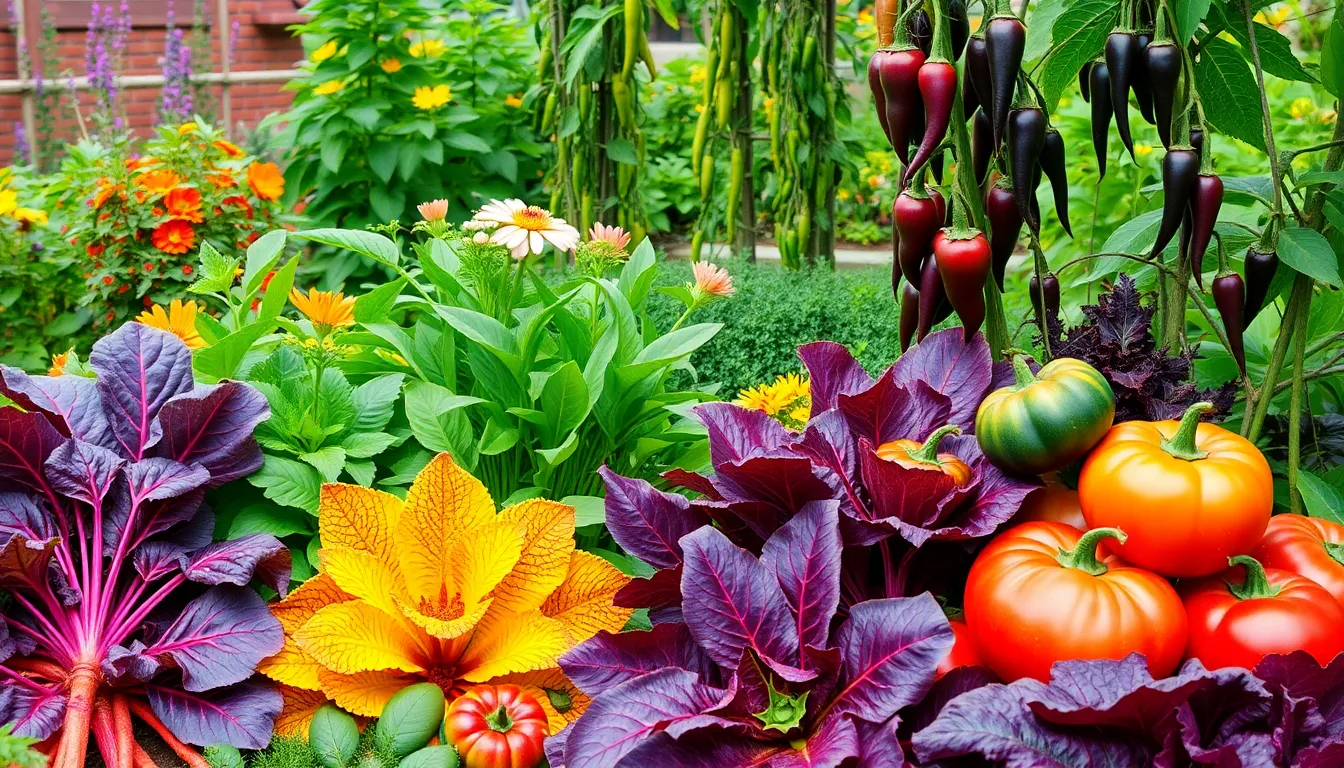
Transforming your garden into a vibrant showcase doesn’t require sacrificing flavor or nutrition. Heirloom varieties bring stunning visual appeal while delivering exceptional taste that surpasses typical grocery store options.
Purple Carrots and Rainbow Chard
Purple carrots create an instant conversation starter in any garden bed or dinner plate. These unique root vegetables contain anthocyanins that provide their distinctive deep purple hue while offering enhanced antioxidant benefits compared to traditional orange varieties. Growing purple carrots requires the same basic care as standard carrots, but we recommend starting seeds directly in loose, well-draining soil for best results.
Rainbow chard delivers continuous harvests of colorful stems throughout the growing season. This leafy green produces vibrant stalks in shades of red, orange, yellow, and white that add dramatic color contrast to garden beds. We find rainbow chard particularly rewarding because you can harvest outer leaves repeatedly while the plant continues producing new growth from the center.
Striped Tomatoes and Unusual Peppers
Striped tomato varieties like Tigerella and Cherokee Purple transform ordinary salads into artistic presentations. Tigerella produces medium-sized fruits with distinctive red and orange stripes, while Cherokee Purple offers deep burgundy coloring with darker striping patterns. These varieties require standard tomato care including consistent watering and full sun exposure for optimal fruit development.
Unusual pepper varieties extend far beyond basic bell peppers in both appearance and flavor profiles. Black Beauty peppers start green and mature to deep purple-black, creating striking visual contrast in garden beds. California Wonder peppers offer reliability alongside their colorful appeal, producing thick-walled fruits perfect for stuffing or fresh eating.
Multi-Colored Bean Varieties
Dragon’s Tongue beans stand out among climbing varieties with their cream-colored pods decorated with distinctive red stripe patterns. These pole beans produce prolifically throughout summer while adding vertical interest to trellises and garden structures. We appreciate how these beans maintain their striking appearance even when cooked, making them perfect for both ornamental and culinary purposes.
Kentucky Wonder beans and Romano beans provide reliable harvests, but Dragon’s Tongue varieties offer superior visual impact without sacrificing productivity. These multi-colored beans climb vigorously and produce tender, flavorful pods that work well in both fresh and preserved preparations.
Include Fast-Growing Succession Planting Ideas
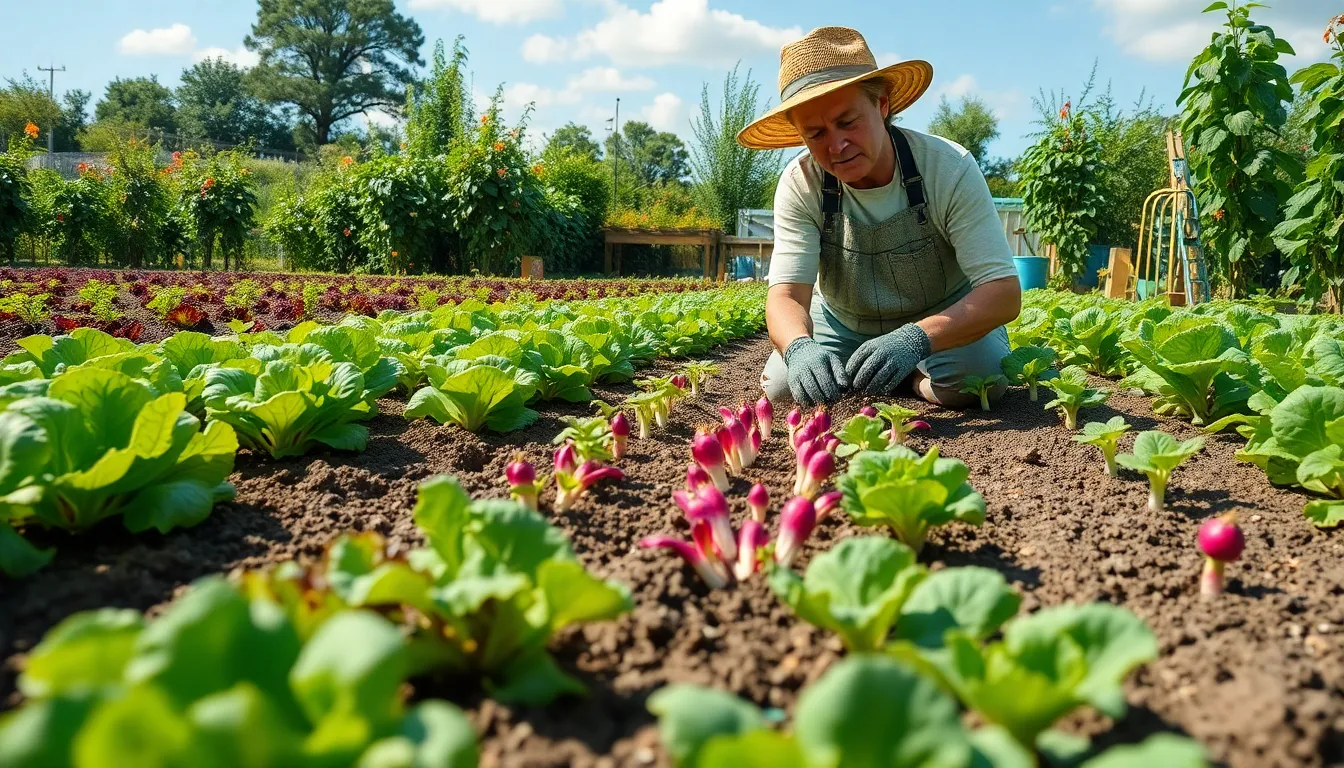
Succession planting transforms our gardens into continuous production systems that deliver fresh harvests throughout the growing season. Strategic timing ensures we’ll never face gaps in our vegetable supply.
Multiple Lettuce Sowings
Multiple lettuce sowings guarantee we’ll enjoy fresh salads from our gardens for months at a time. Plant lettuce in multiple small batches from October through February to extend the harvesting period and provide a steady supply of fresh leaves. Baby leaf lettuce and greens respond exceptionally well to this approach, requiring new sowings every 7 days for optimal results. These varieties can be planted up to 4 weeks before the first frost date, especially when we use protective covers like row covers or cold frames.
Timing becomes crucial for maximum success with our lettuce succession plantings. Small batch plantings prevent overwhelming harvests while ensuring consistent availability throughout the cooler months. Protected growing extends our planting window significantly, allowing us to push the boundaries of traditional growing seasons.
Staggered Bean Plantings
Staggered bean plantings deliver prolonged harvests instead of overwhelming gluts that traditional single plantings often produce. Plant bean seeds every 10 to 14 days to ensure a continuous supply throughout the growing season. Bush beans work particularly well for succession planting since they mature quickly and don’t require trellising support.
Fresh plantings compensate for declining productivity in older bean plants, maintaining consistent yields over extended periods. Each successive planting reaches maturity as previous plantings begin to slow down, creating an overlapping harvest schedule. Weather variations affect individual plantings differently, so staggered timing provides insurance against unexpected growing conditions.
Continuous Radish Harvests
Continuous radish harvests keep our tables supplied with these quick growing roots throughout the growing season. Plant radish seeds every 7 days to maintain steady production, as radishes can be sown up to 4 weeks before the first frost date. Fast growing varieties like Cherry Belle mature in just 22 to 30 days, making them perfect candidates for frequent succession plantings.
Weekly sowings prevent radishes from becoming woody or bolting before we can harvest them. Short growing cycles mean we can fit multiple crops into spaces that longer season vegetables would occupy for months. Cold tolerance allows us to continue planting radishes well into fall when many other vegetables have finished producing.
Design Companion Planting Vegetable Combinations
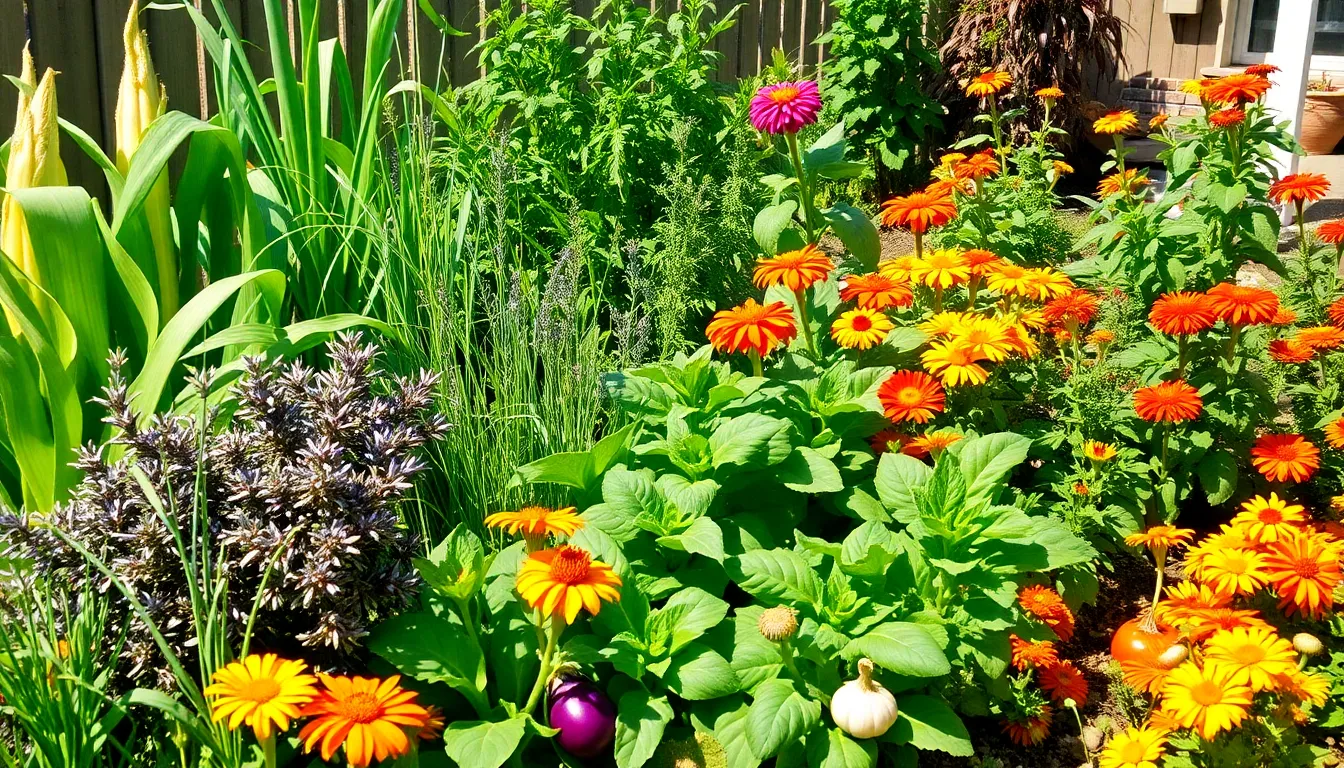
Companion planting transforms your garden into a thriving network where plants support each other’s growth and health. Strategic plant combinations can boost yields, reduce pest problems, and enhance flavors naturally.
Three Sisters Garden Layout
The Three Sisters method creates a powerful partnership between corn, beans, and squash that maximizes garden space while improving soil health. Corn stalks provide natural trellises for bean vines to climb, eliminating the need for additional support structures. Beans fix nitrogen in the soil, enriching it for their companion plants throughout the growing season.
Squash plants spread across the ground, creating a living mulch that shades soil and prevents weed growth. This ground cover also helps retain soil moisture during hot summer months. Plant corn first, followed by beans when stalks reach 6 inches tall, then add squash seedlings around the perimeter of your corn rows.
Herb and Vegetable Pairings
Chives paired with lettuce attract beneficial pollinators that increase lettuce yields while deterring harmful insects. Plant chives around lettuce beds to create natural pest barriers that enhance crop production.
Thyme grown alongside eggplant repels whiteflies and cabbage worms while improving eggplant’s natural flavor profile. Position thyme plants between eggplant rows for maximum pest deterrent effects.
Calendula flowers planted near broccoli repel aphids effectively while attracting beneficial insects like ladybugs and lacewings. These colorful blooms also add visual appeal to your vegetable garden layout.
Basil companions with tomatoes enhance tomato flavor significantly while repelling common pests like hornworms and aphids. Plant basil directly beneath tomato plants or in nearby containers for best results.
Pest-Deterrent Plant Partnerships
Marigolds strategically placed throughout vegetable plots reduce aphid populations by up to 50% according to garden research studies. These vibrant flowers also deter nematodes and other soil-dwelling pests naturally.
Garlic planted around vulnerable crops repels aphids, Japanese beetles, and carrot root flies effectively. Position garlic bulbs at garden bed edges or intersperse them between rows of susceptible vegetables.
Nasturtiums serve as trap crops that attract beetles and aphids away from valuable vegetables like cabbage and broccoli. Plant nasturtiums around garden perimeters to create protective barriers.
Rosemary positioned near brassicas deters cabbage moths and other flying pests with its strong aromatic oils. This hardy herb thrives in most garden conditions while providing continuous pest protection.
Sage planted alongside cabbage family vegetables repels cabbage moths, flea beetles, and slugs through its potent natural compounds. Space sage plants every 3-4 feet along cabbage rows for optimal coverage.
Conclusion
Growing our own vegetables transforms how we connect with our food while providing practical benefits that extend far beyond the dinner table. Whether we’re working with a sprawling backyard or a small balcony space we can create productive gardens that deliver fresh nutritious produce throughout multiple seasons.
The strategies we’ve explored—from quick-growing greens to vertical gardening techniques—prove that successful vegetable gardening doesn’t require extensive experience or perfect conditions. By choosing the right varieties for our climate and space we can enjoy continuous harvests while building confidence in our gardening abilities.
With succession planting companion growing methods and season-extending techniques we can maximize our garden’s potential year-round. These approaches ensure we’re never without fresh homegrown vegetables while creating sustainable growing systems that improve with each season.
Frequently Asked Questions
What vegetables are best for beginner gardeners?
Start with easy-to-grow varieties like lettuce, spinach, radishes, and bush beans. These vegetables are forgiving, grow quickly, and don’t require extensive gardening experience. Leafy greens like Black Seeded Simpson lettuce and spinach mature in just a few weeks, while radishes like Cherry Belle are ready to harvest in about 30 days.
How can I maximize vegetable production in a small space?
Use vertical gardening techniques with trellises for climbing plants like pole beans, cucumbers, and indeterminate tomatoes. Choose compact varieties such as dwarf peppers and bush squash. Hanging baskets work well for cherry tomatoes, and succession planting ensures continuous harvests throughout the season.
What are the benefits of growing your own vegetables?
Growing your own vegetables provides fresher meals, reduces grocery costs, and offers personal fulfillment. You’ll have access to unique heirloom varieties not found in stores, better flavor from vine-ripened produce, and the satisfaction of cultivating your own food while knowing exactly how it was grown.
Which vegetables can I grow in winter or cold weather?
Cold-hardy vegetables include winter spinach, kale, Brussels sprouts, cabbage, beets, carrots, and parsnips. These plants tolerate frost and often develop sweeter flavors after cold exposure. Many can be harvested well into fall and winter, extending your growing season significantly.
What is succession planting and why should I use it?
Succession planting involves sowing small batches of vegetables at regular intervals rather than planting everything at once. This technique ensures continuous harvests throughout the season, prevents overwhelming yields, and maintains fresh produce availability. It works especially well with lettuce, beans, and radishes.
How does companion planting improve my vegetable garden?
Companion planting pairs plants that benefit each other’s growth and health. The Three Sisters method (corn, beans, squash) maximizes space and soil nutrition. Herbs like basil with tomatoes and chives with lettuce improve yields and flavor while deterring harmful pests naturally.
What vegetables thrive in hot summer weather?
Heat-loving vegetables include eggplant, hot peppers, okra, summer squash, and sweet corn. These plants require full sun, well-drained soil, and consistent watering during extreme heat. They produce abundant yields during the hottest months when many other vegetables struggle.
Do I need a large yard to grow vegetables successfully?
No, you can grow vegetables in containers, small raised beds, or even on balconies and patios. Choose compact varieties like bush beans, dwarf peppers, and determinate tomatoes. Vertical growing methods and hanging baskets maximize production in minimal space while providing excellent results.

